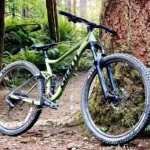If you’ve ever wanted to ride those rocky trails through the hills and mountains, then you’ve thought about riding a mountain bike. They are designed for those rugged and rocky trails and seems like they are only walkable.
Mountain bikes differ from the average bike most people are aware of. They have a frame that is more upright so that you have higher clearance, can see better, and have a better center of gravity. These rugged frames are designed to allow the bike to handle the stress of the more demanding trails, while at the same time making it easier on the rider.
Mountain bikes have more or less the same parts as many bikes, but the parts are more heavy duty to handle the harder demands of the mountain trails. There are even different types of mountain bikes which have to meet different needs.
Types of Mountain Bikes
There are lots of different bikes that are still similar like hybrid bikes and hardtail bikes, but most mountain bike types fit into two categories:
Trail Bikes
Trail bikes are meant for downhill mountain biking where you start at the top of a mountain and work your way down trails to the bottom. Many of these involve smaller jumps and frequently obstacles like large rocks and fallen trees. The ground may be very wet or muddy. Often times you are zipping between trees and it’s like an obstacles course setup by mother nature. It’s a lot of fun but bikes used like this need to be heavy duty to take the stress on the parts.
Within trail bikes, there are lots of subcategories such as downhill bikes and fat tires bikes. Downhill bikes are made to handle huge jumps and drops coming down mountain trails. Fat tire bikes are trail bikes which are made with 4+ inch wide tires so that can ride over unstable terrain such as sand and snow and not sink in. There are a lot of different types of bikes within the trail bikes category and each excels in its target environment tremendously.
The trail bikes category includes all mountain bikes, all mountain enduro bikes, freeride mountain bikes, and downhill bikes.
If you like adrenaline-inducing sports, then this is the one for you.
XC Bikes
XC, or Cross Country, bikes run on more mild ground than the trail bikes. XC bikes are meant to be used on mild trails including even some jumps, singletrack through different landscapes, dirt roads, and more. Generally the more mild side of being offroad.
Cross country biking generally aims for fast times through trails while downhill trail biking concentrates more on technical maneuvering over difficult terrain.
There are more than one type of cross country bikes, so they include XC bikes that are hardtail and full suspension mountain bike models. Hardtail bikes only have a front suspension and no rear suspension. Full suspension mountain bike models have both a full front and rear suspension to help absorb the bumps.
Full suspension mountain bikes tend to cost a little bit more but are well worth it if it fits within your budget. Mountain bikes cross country models typically have both options available. Obviously full suspension bikes are the choice for most riders when possible.
I should note here that downhill bikes typically also have a full suspension with lots of travel to handle those big jumps.
I have an entire article devoted to just xc vs trail bikes if you want to take a look.
Frame
Most entry-level mountain bike frames are built out of steel due to costs. Steel is very strong and rigid allowing it to take abuse and stress. However, steel is heavier and can rust. As the materials get more advanced, the price increases more.
Aluminum is light, rust-proof, and strong. However, it is not immune to breakage over time when under constant stress. For many riders riding through rugged terrain, aluminum may not be ideal.
Carbon-fiber frames are light, rust-proof, and very strong. Sadly they are prone to breakage, but it will occur suddenly, and often at the worst time.
Finally, top-of-the-line mountain bike frames are made from titanium. Titanium is amazingly strong and super light. Unlike aluminum and carbon-fiber frames, a mountain bike built out of aluminum will be able to handle repeated stress and abuse. However, titanium is incredibly expensive. Bikes built out of titanium are often ridden by mostly serious or competitive cyclists.
Wheels
Modern mountain bikes typically have either 27.5 or 29 inch wheels. The tires can be anywhere from 2 to 2.5 inches wide depending on if speed is needed or stability with the wider knobby tires is more desirable.
These tires offer more substantial grip and traction on surfaces from rock to sand. The pressure on mountain bikes is less than road bikes due to their greater volume and better traction offered by softer tires. The rims are stronger and more durable to take abuse and stress when riding through rougher terrain. Just remember to check your tires periodically to ensure they still have tread and don’t have the dreaded cracks in the sidewalls.
Gears
Mountain bike gears vary from road bike gears. Rarely is there a need for blazing speeds, so most mountain bike only offer low gears. These low gears go below that of most road bikes. The purpose of lower gears is to allow mountain bikers to climb steeper hills with ease.
A mountain bike will typically offer either two or three chainrings in the front. The back will have eight or nine gears, many which are designed for steep climbs. This combination allows for 16 to 27 possible gear combinations. These gear combinations account for almost any type of terrain a mountain biker will encounter.
Handlebars
Mountain bike handlebars typically are flat. These handlebars are generally shoulder width to allow for a wider grip. These handlebars are designed to allow riders to sit upright offering better vision and control of the bike on tough terrain.
Pedals
Common mountain bikes come equipped with platform pedals. This is easier on riders who frequently put their feet down. Alternatively, there are clipless pedals for mountain bikes. These allow the rider to secure their cleated shoes to the pedals. However, for new riders, platform pedals are recommended. Whichever type you choose, make sure you pick the right mountain bike shoes for your equipment.
Have Fun Out There
Whichever type of mountain bike you choose, make sure you have all of the needed gear ready so you can have good safe fun in this sport. I have an article over here on the list of essentials that every new person needs before they hit the trails.



